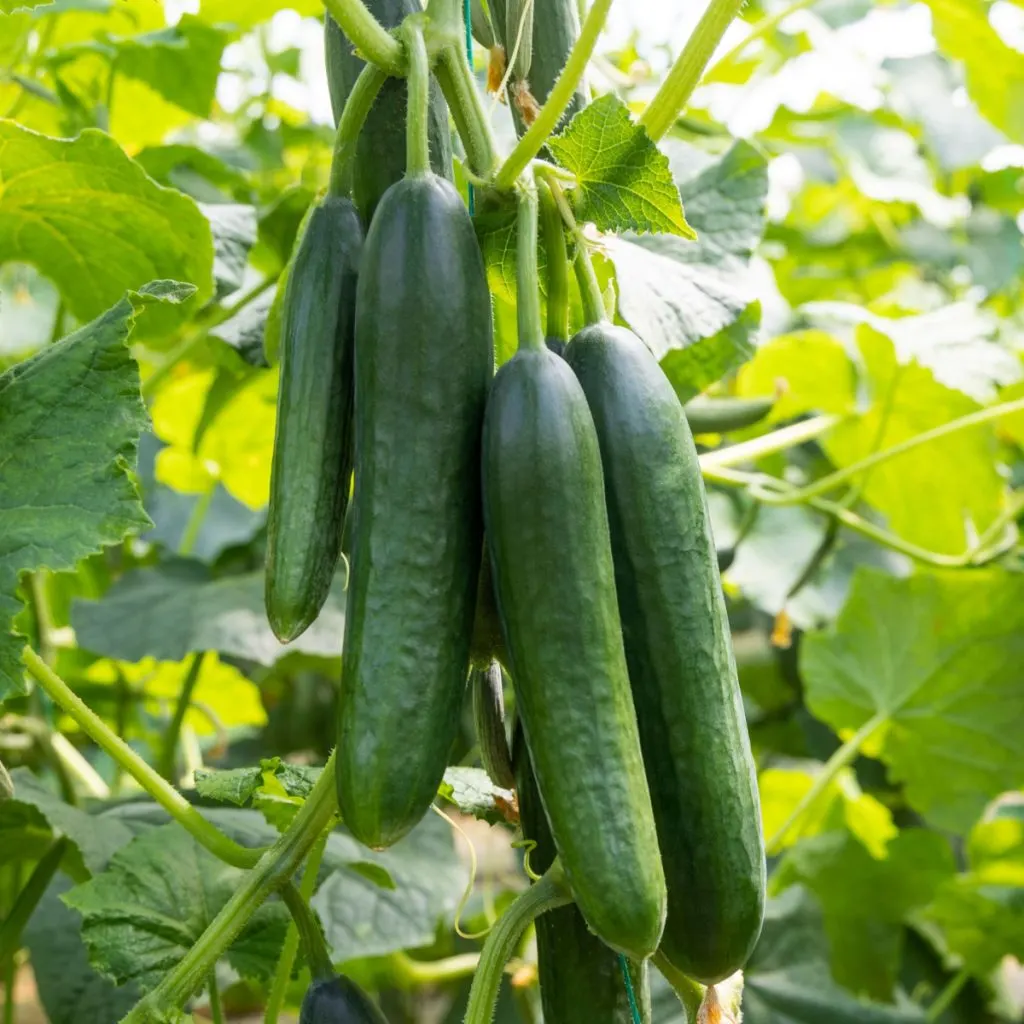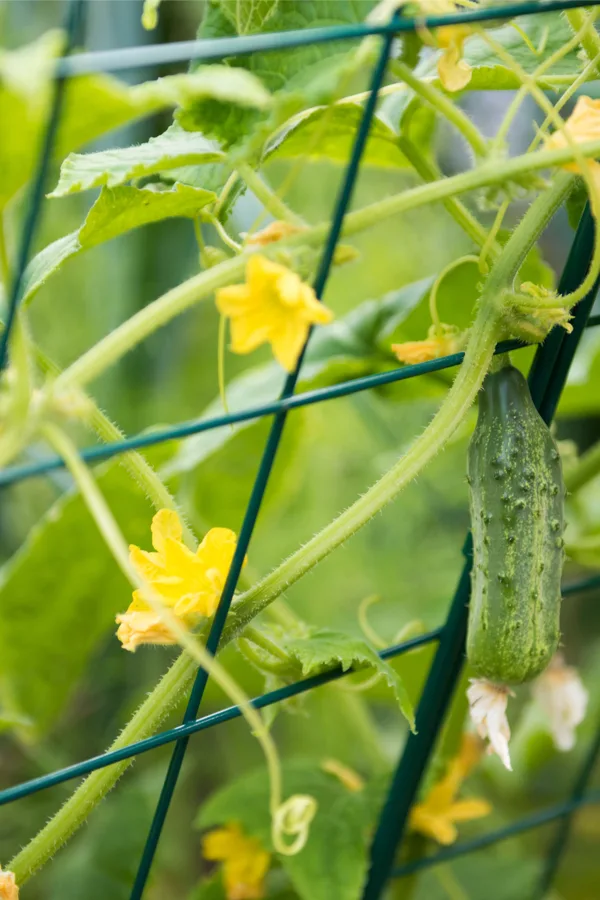Looking for a few simple secrets to keep your cucumber plants productive and get more cucumbers than ever this summer?
Unfortunately, for many gardeners, keeping their cucumber plants productive can be a challenge. Especially as the long, hot days of summer arrive. All too often at the mid-season point, plants that were once producing loads of blooms and fruit begin to suddenly slow their production.
Are they running out of energy? Are they not getting enough water? Or are they simply at the end of their life cycle? The good news is that as long as you make sure to regularly pick your plants and give them the water and nutrients they need – you can keep your cucumber plants producing well right into late fall. But let just one of those chores slip a bit, and your cucumber plants will begin to suffer quite quickly.

With that in mind, here is a look at the three simple secrets to keep your cucumbers flowering and producing all summer long!
3 Simple Secrets To Get More Cucumbers From Your Plants!
1. Pick Your Plants Often!
Believe it or not, how often you pick your cucumbers plays a big role in how productive your plants will stay. In a nutshell, the more you pick your plants, the more your plant will produce over the course of its life.
Why does this matter? Because when a cucumber plant becomes overloaded with too many cucumbers, it will begin to halt production of new blooms. In fact, if too many large fruit are still on the vine, it will stop creating new blooms entirely.
The plant does this to concentrate all of its energy on ripening all of the existing fruit. With so much fruit already on the vine, the plant simply does not need to create any more blooms. This phenomenon is often referred to as a “fruit load” or “fruit overloading” – and it actually occurs when nearly all vegetable plants have too much remaining fruit.
When this happens, it can highly impact your harvest. Without additional blooms forming, there will be no future fruit to pick. Which is exactly why it’s so important to keep fruit load to a minimum!

Harvest Often
Harvest your cucumber plants regularly. Pick fruits when they are on the slender and smaller size for better taste and freshness. Picking in this fashion also helps to keep your cucumbers from filling up with too many seeds.
Anyone who has ever grown cucumbers knows how quickly a two inch small cucumber can become an overgrown, seed-filled monstrosity. In fact, it can happen in just a day or two. Unfortunately, when it does, it uses a tremendous amount of energy from the plant. Energy that should be going to form new blooms and future cucumbers!
2. Fertilize Your Plants For Production – 3 Simple Secrets To Get More Cucumbers From Your Plants!
In addition to keeping your plants harvested, it’s also a must to give your plants the nutrients they need to power bloom and fruit production. Whether you grow your cucumbers in containers, raised beds or a traditional garden, cucumber plants can quickly deplete the soil of the nutrients they need most. And when the energy is gone – the plants will struggle to produce.
Once plants are established, it’s best to provide them with a light, steady supply of energy. Giving your plants a dose of liquid fertilizer every two weeks is the best option for this.
Liquid fertilizers work fast. Their nutrients are absorbed through the leaves and the roots of plants, getting energy to the plant quickly. You can use a low and slow granular fertilizer to power your plants, but it will not have the same short term effect to keep them producing.

Also of major importance is what type of nutrients you feed them. Although nitrogen is important for growth, it is phosphorous and potassium that are needed most for production of blooms and for ripening the cucumbers.
Because of this, select a liquid soluble fertilizer that is far higher in phosphorous and potassium. Your plants will reward you with loads of blooms, and a lot more fruit! Here are two great options:
- Affiliate Product Link: Farmer’s Secret Fruit & Bloom Booster Fertilizer (32oz)
- Affiliate Product Link: Greenway Biotech Cucumber Fertilizer 8-16-36-100% Water Soluble
3. Don’t Forget To Water – 3 Secrets To Get More Cucumbers From Your Plants
Cucumbers, like many other vegetables, are comprised mostly of water. Because of that, they need a great deal of moisture to sustain healthy, highly productive plants.
During the spring and early summer, rainfall tends to be more plentiful and consistent. Add in that temperatures are usually a bit cooler, plants are normally able to get and retain plenty of moisture for steady growth.
As summer settles in, however, rainfall can often become more sparse and less frequent. The higher heat and intensity of the sun’s rays also dry out the soil and the cucumber plant’s roots at a much faster rate – and plants can suffer quickly from dehydration. See our article: The 3 Biggest Garden Watering Mistakes – And How To Avoid Them!

How To Water Cucumber Plants In The Summer – How To Keep Cucumber Plants Producing
For healthy, productive cucumber plants, two inches of rainfall or watering each week is a must. Especially in the hot, more arid summer conditions. Water plants at regular intervals. Be sure to water deeply so that the roots can drive down deep in the soil.
It’s important to water at the soil level, being careful not to water the foliage. Cucumber plants can be highly susceptible to powdery mildew and wet leaves are often the main culprit.
Finally, and this is extremely important for cucumbers, mulch your plants heavily! A good 4+ inch layer of straw or grass clippings can help conserve soil moisture and regulate the soil temperature. It also will help to protect your ripening fruit from rotting in the soil.
Here’s to taking care of your cucumbers this summer – and to getting more produce than ever from your plants!
This Is My Garden
Follow Our Facebook Page For Great Gardening Tips And Advice! This Is My Garden Facebook Page
This Is My Garden is a garden website created by gardeners, for gardeners. Jim and Mary Competti have been writing gardening, DIY and recipe articles and books and speaking for over 15 years from their 46 acre Ohio farm. They publish three articles every week, 52 weeks a year. Sign up today to follow via email, or follow along!
